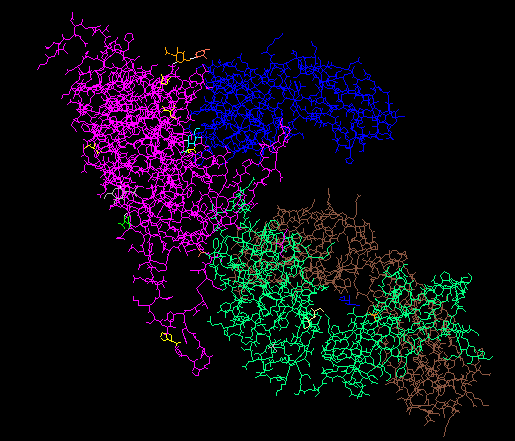AVM BIOL368 Week 11
Purpose
The purpose of this weeks lab is to present the start of our research projects to the class and receive some feedback to move forward with our work. We will then finalize our powerpoints and projects and keep track of our progress on our electronic notebooks.
Methods and Results
HIV Structure Project: Improvement to do list: Explain why we chose our subjects significance test continue with clustldist - explain what data means most different from starting point divergence? max distance values types of mutations look more at structure create outline background info
- Mutations were observed for each subject on each part of the structure with the use of the Huang et al virtual gp120.
- Mutations were then analyzed based on the conservation of the type of amino acid
- the mutations could either be conservation of strong groups, weak groups, or no consensus
- We did this by looking at an amino acid chart and found what two amino acids were being exchanged or what was being deleted
- The locations of the mutation within the structure was also noted
- Because there were so many mutations for some of the subjects (24 for subject 10) we found the most prevalent mutations that were more likely to effect the structure
- This was determined by analyzing the "no consensus" mutations for each subject
- Below is a boxshade (shows mutations within the subject) of nonprogressor 13
- Different amino acid sequence mutations occurred in different locations on gp120
- Below is the different mutations which occurred in nonprogressor 12
Data and Files
Conclusion
In conclusion, there was no correlation between amino acid sequences and diversity among progressor groups. The different types of mutations observed in each subject didn't show any significant patterns among groups or any area of the structure. To further analyze our subjects from last week we used boxshade, multiple sequence alignment, rooted trees and clustaldist on biology workbench. The structure developed by Huang et al. was used to observe where the mutations occurred within gp120 and see if that could affect the severity of the mutation. To determine if there is any correlation between diversity and progressor groups more subjects would need to be analyzed. These subjects would also need to have more data points to be better represented. In general, different mutations occurring within the amino acid sequences have the ability to affect the virus based on the severity of the amino acid change and the location on the structure.
Acknowledgments
- Worked in collaboration with research partner Mia Huddleston in class.
- We collaborated on our presentation both in class and at home throughout the week.
- Template followed from week 11 found at BIOL368/F16
- Help from our professor, Dr. Dahlquist in class.
- Note: While I worked with the people noted above, this individual journal entry was completed by me and not copied from another source.
Avery Vernon-Moore 16:21, 8 November 2016 (EST)
References
- Huang, C. C., Tang, M., Zhang, M. Y., Majeed, S., Montabana, E., Stanfield, R. L., ... & Wyatt, R. (2005). Structure of a V3-containing HIV-1 gp120 core. Science, 310(5750), 1025-1028.
- Kirchherr, J. L., Hamilton, J., Lu, X., Gnanakaran, S., Muldoon, M., Daniels, M., Kasongo, W., Chalwe, V., Mulenga, C., Mwananyanda, L., Musonda, R.M., Yuan, X., Montefiori, D.C., Korber, M.T., Haynes, B.F., & Musonda, R. M. (2011). Identification of amino acid substitutions associated with neutralization phenotype in the human immunodeficiency virus type-1 subtype C gp120. Virology, 409(2), 163-174. DOI: 10.1016/j.virol.2010.09.031
- Markham, R.B., Wang, W.C., Weinstein, A.E., Wang, Z., Munoz, A., Templeton, A., Margolick, J., Vlahov, D., Quinn, T., Farzadegan, H., & Yu, X.F. (1998). Patterns of HIV-1 evolution in individuals with differing rates of CD4 T cell decline. Proc Natl Acad Sci U S A. 95, 12568-12573. dos: 10.1073/pnas.95.21.12568
Weekly Assignments:
Assignment 1 Assignment 2 Assignment 3 Assignment 4 Assignment 5 Assignment 6 Assignment 7 Assignment 8 Assignment 9 Assignment 10 Assignment 11 Assignment 12 Assignment 14 Assignment 15
Individual Journals:
"Week 1: Create Wiki Page" Individual Journal 2 Individual Journal 3 Individual Journal 4 Individual Journal 5 Individual Journal 6 Individual Journal 7 Individual Journal 8 Individual Journal 9 Individual Journal 10 Individual Journal 11 Individual Journal 12 No Week 13 Assignment Individual Journal 14 Individual Journal 15
Class Journal 1 Class Journal 2 Class Journal 3 Class Journal 4 Class Journal 5 Class Journal 6 Class Journal 7 Class Journal 8 Class Journal 9 Class Journal 10 Class Journal 11 Class Journal 12 Class Journal 14 Class Journal 15

